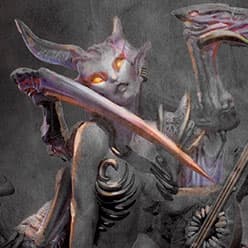Aria
Classes
Attributes
| MOV | MEL | RNG | MAG | AGI | RES | SH |
|---|---|---|---|---|---|---|
| 3 | 6 | 7 | 5 | 0 | 4 |
Weapons
| Name | Type | Cost | Reach | Glance | Solid | Crit |
|---|---|---|---|---|---|---|
| Serpent | MEL | 1AP | 1 | 2 | 3 | 4 |
| Symphonic | MAG | 2AP | 4 | 3 | 4 | 6 |
Innate Abilities
Active Abilities
Combat Manoeuvres
Frequently Asked Questions
As per page 96 of the rulebook: Away / Towards, when making an Advance the model must take the shortest route possible. Each hex in the Advance must decrease the distance between the model that cast Allure and the target. Models can move around occupied hexes if required.
No. The enemy has to have been damaged during the current attack action.
The attacking model can use a Push manoeuvre to push the target while Duplicate Self is active if three dice selected for the attack do not include the hit (crossed swords) or J symbols. Note: pushing a model without a hit or J symbol does not remove Duplicate Self.
Duplicate Self ignores damage & Combat Manoeuvres resulting from the Basic Attack that targeted the caster. Note, the attack action still occurs and the enemy model can trigger Combat Manoeuvres that affect itself resulting from a Basic Attack that targets the model under Duplicate Self.
The active player can choose any combat manoeuvres available on the enemy model's card, and the generic combat manoeuvres listed on page 46 of the core rulebook, if the basic attack satisfies the manoeuvre's conditions. Note, monsters are still not able to perform generic combat manoeuvres. The enemy model becomes a friendly model to the casting model's Warband for the duration of the attack. If the attack from Suggestion kills an enemy model, the casting model will gain the level, Soul and/or bounty (if the slain enemy model was a monster and either the casting model or the Suggested ally was adjacent to the monster when it died). The caster is considered to own any conditions that are caused as a result of this attack.
Yes, innate abilities are still applicable.
The enemy model becomes friendly to the model using Suggestion and becomes a part of that model's warband during the basic attack. The enemy model gains the benefits of the friendly God, including Champion or Avatar benefits, as applicable.
Yes, that model can still activate. Sleep cannot be used to prevent the last model of a warband from activating.
No, a model cannot begin an Advance or Charge while adjacent to a model with Stone Grasp, including effects that happen outside of its activation.
Aria must first choose the number of hexes to move the model with the advance, then choose from legal paths using the chosen movement.
Yes.


